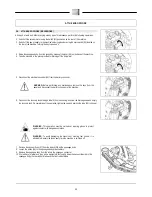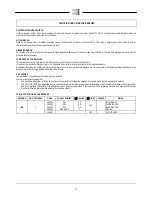
45
TROUBLESHOOTING
54.
THE MACHINE DOES NOT START
1.
Check that batteries are charged
2.
Make sure the electric system connector is connected to the battery connector
3.
Check that the key switch is in position “I” (B-BT versions).
55.
INSUFFICIENT WATER ON THE BRUSHES
1.
Check there is water in the solution tank
2.
Check that the detergent solution release adjustment knob (1) is open.
3.
Clean the solution filter (02) located on the rear left part of the machine.
56.
THE SQUEEGEE DOES NOT DRY PERFECTLY
1.
Check the squeegee is clean
2.
Check the squeegee adjustments (see “EMERGENCY MAINTENANCE”).
3.
Clean the entire vacuum unit (see “WEEKLY MAINTENANCE”)
4.
Replace the squeegee body rubbers, if worn.
57.
THE MACHINE DOES NOT CLEAN WELL
1.
Check the state of wear and tear of the brushes and, if necessary, replace them. The brushes should
be changed when the bristles are about 15mm long. To replace these, see paragraph “BRUSH
REPLACEMENT ” in the chapter “EMERGENCY MAINTENANCE”. Working with an over-worn brush
may cause damage to the floor.
2.
Use a different kind of brush to the one fitted as standard. For cleaning floors where the dirt is
particularly resistant, we recommend the use of special brushes supplied upon request and according
to needs (see chapter “CHOOSING AND USING THE BRUSHES”).
58.
EXCESSIVE FOAM PRODUCTION
Check that a low foam detergent has been used. If necessary, add a small quantity of antifoam liquid to the
recovery tank.
Remember that, when the floor is not very dirty, more foam is generated. In this case the detergent solution
should be more diluted.
59.
THE VACUUM CLEANER DOES NOT FUNCTION
1.
Check whether the recovery tank is full and, if necessary, empty it.
2.
Check the correct operation of the float in the recovery tank (see also “CLEANING THE RECOVERY
TANK FILTER” in the chapter “DAILY MAINTENANCE”)
60.
THE BRUSH MOTOR DOES NOT WORK
WARNING To avoid damaging the floor, the motor only starts up when the machine is moved forwards
1.
Check that the brush head is in contact with the ground when moving forwards.
2.
Check the motor is correctly connected to the machine's electrical system.
































